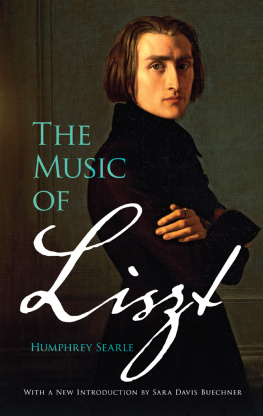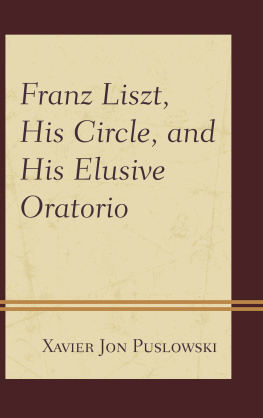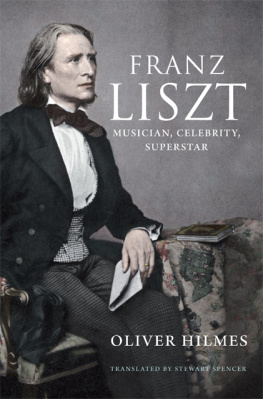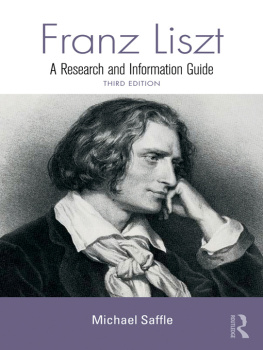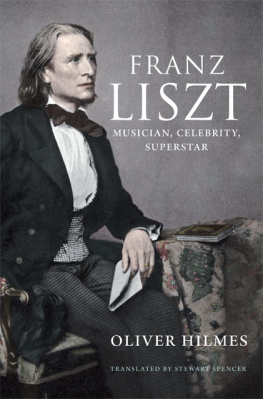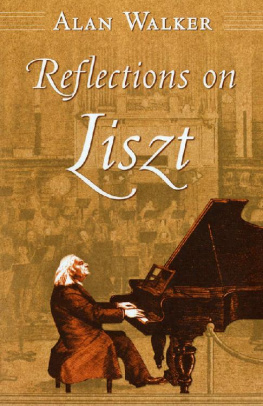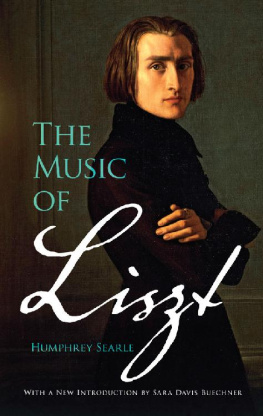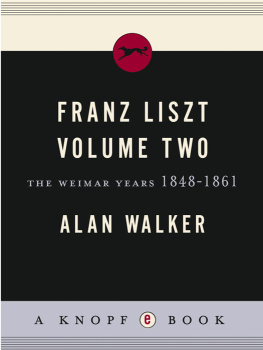THE
MUSIC
OF

HUMPHREY SEARLE
WITH A NEW INTRODUCTION BY
SARA DAVIS BUECHNER
DOVER PUBLICATIONS, INC.
MINEOLA, NEW YORK
Bibliographical Note
This Dover edition, first published in 2012, is an unabridged and revised republication of the work first published by Williams & Norgate Ltd., London, in 1954. It contains a preface prepared by the author in 1966. Sara Davis Buechner has prepared a new Introduction for this 2012 edition.
International Standard Book Number
eISBN-13: 978-0-486-78640-7
Manufactured in the United States by Courier Corporation
48793801
www.doverpublications.com
In Memory of
CONSTANT LAMBERT
ACKNOWLEDGMENTS
MY THANKS are due to the President and Council of the Royal Musical Association for permission to reproduce those parts of which originally appeared in Proceedings of the Royal Musical Association, Vol. LXXVIII ; and to Messrs. Breitkopf & Hrtel for permission to reprint the quotation from Busonis edition of the Paganini-Liszt tude No..
H. S.
INTRODUCTION
Written in fond affection and memory of Joseph Bloch (1917-2009), who used this book in his Piano Literature lectures on Franz Liszt at the Juilliard School.
LISZTS OEUVRE
The music of Franz Liszt (18111886) continues to amaze current generations even as it did Liszts own, and those who immediately followed him; and it is the safest of bets that it shall continue to amaze, confound, and delight music lovers for eternity. For pianists particularly, Liszt is a touchstone figureone of those select few composers who, like Chopin and Debussy, defined the very essence of pianism through his musical soul. That his life was as richly Romantic and thunderously vigorous as his piano playing, is but a boon to biographers who have lavished their attentions on the sensual combination of virility, stage command and Heaven-storming pathos that the demonic Franz Liszt- pastoral collar round his neck, eyes fixed towards Paradise, Satanic wart-growths flecked upon his nose, hands crushing keyboards and beautiful women simultaneously with Mephistophelian easehas come to immortalize. Concert pianists are no less hypnotized than the general public by those performers whose technical command admits them to the select Pantheon of virtuosi able to surmount the near-inhuman demands of such masterworks as the Sonata in B minor, Annes de Plerinage, Paganini Studies, Transcendental Etudes, Operatic Fantasies on Don Juan, Rigoletto, Norma, Oberon, et al. It is those lucky musicians who investigate the complexities of such scores who come away with a schooling, not only in simplistic terms of an introduction to the heights of bravura possible on the piano. Pianists who study Liszts seemingly bottomless oeuvre are amply rewarded with a deep and abiding respect for his mastery of form, keyboard orchestration, transcription, sheer invention, and sense of sonorous splendor. Franz Liszt, it may be said, was in fact the very personification of the piano. Although there are those who dislike his musicoften, those who cannot fathom nor handle its challengeseven they dare not ignore it. A musician who does not come to terms with Liszt is like a New Yorker who fails to find the Empire State Building for lack of searching upward.
Part of the challenge to learning Liszts music is the sheer amount of itprobably over a thousand works of which the enormous output for piano is but a part (enough for at least 75 CDs). There are orchestral and choral works, chamber music, songs, and an opera; and for the keyboard, a seemingly bottomless trove of original works for two and four hands; one and two pianos; paraphrases, transcriptions, and arrangements of music by other composers tooBach, Beethoven, Berlioz, Chopin, Gounod, Mendelssohn, Mozart, Rossini, Schubert, Schumann, Weber, many more. The unmatched abundance of Liszts musical output is a daunting wall to the student who wishes to gain an appreciation of his general style and musical language. Where to start? What are the major works? Minor works? Works that exist in more than one version? Experiments successful and non, and landmarks of note?
The Music of Liszt by Humphrey Searle was the first book in English to discuss Liszts music in a scholarly fashion, with a comprehensive appraisal of his compositions arranged in chronological order, and grouped in relation to specific periods of Liszts life. Its only real predecessor, in German, was Peter Raabes Franz Liszt (Stuttgart, 1931). When Searles volume appeared in 1954 (published by Williams & Norgate), interest in Liszts experimental later compositions was just beginning, fuelled also by the first publications, by Schott and Co. in London, of the Liszt Society. Thus it is with particular interest to read Searles descriptions of such works as En Rve or the Third Mephisto Waltz, which were then being rediscoveredthanks largely to Searles own efforts.
This volume remains an exceedingly persuasive and helpful research guide, particularly for the student who is freshly embarking on research into Liszts life and work, as well as for the pianist (or other musician) who wishes to know important background material about a work he or she may be undertaking to perform, analyze, or listen to. Searles concluding biographical survey is particularly helpful in matching works to specific events in Liszts life. The catalog provided at the end of this volume is likewise of use, but at this point in time should not be regarded as the last word; readers are advised in any case to consult Alan Walkers comprehensive biography of Franz Liszt (published by Alfred A. Knopf, in three volumes, 1983, 1989, 1996) for further elucidation and corrections, and to examine internet sources that are better able to update timely corrections or evaluation of newly-discovered scores.
SEARLE AND LISZT
After early compositional studies with John Ireland at the Royal College of Music, Humphrey Searle became a pupil of Arnold Schoenbergs disciple Anton Webern in Vienna. Returning to England shortly before the outbreak of World War II, Searle became one of the leading British proponents (along with Elizabeth Luytens) of twelve-tone music. His bent as a musician strongly gravitated against the conservative grain, and he found allies in such notable leading figures as William Walton, Constant Lambert, Walter Goehr and Ren Leibowitz. Among his own compositions are five Symphonies (the last dedicated to the memory of Webern), two Piano Concertos, numerous chamber and vocal works, and several important operas including Hamlet (1968). In his later years, he returned to the Royal College of Music as a teacher, and numbered Michael Finnissy among his many illustrious pupils.
Humphrey Searle became fascinated with the music of Franz Liszt at a time when relatively little was understood about the importance of the Hungarian pianists place in music history, and the full extant of his compositional output was only beginning to become known. The legacy of Liszt as Hyper-Romantic virtuoso la the Hollywood biopic Song Without Endhelped to undermine more sober assessments of his tremendous contributions to the development of music as a pianist, composer, conductor, and pedagogue. However, a fortuitous anniversary brought about a new view of Liszt, in the eyes of Searle.
1936 was the 50th anniversary of the death of Liszt, noted Searle in a lengthy autobiographical essay entitled Quadrille with a Raven, written shortly before his death in 1982. I had previously underrated this composer, having been taught that he was flashy and vulgar, but in 1936 three things happened which opened my eyes to his importance. My friend Ronald Crichton introduced me to the Annes de Plerinage, beautiful and original lyrical pieces which are certainly neither flashy nor vulgar; I read Sacheverell Sitwells biography of Liszt published two years earlier, which gives a fascinating picture of Liszts character and the times in which he lived, and the Vic-Wells Ballet put on Apparitions to music by Liszt, chosen by Constant Lambert mostly from Liszts late experimental pieces and skilfully orchestrated by Gordon Jacobthe young Margot Fonteyn was the leading ballerina.
Next page
